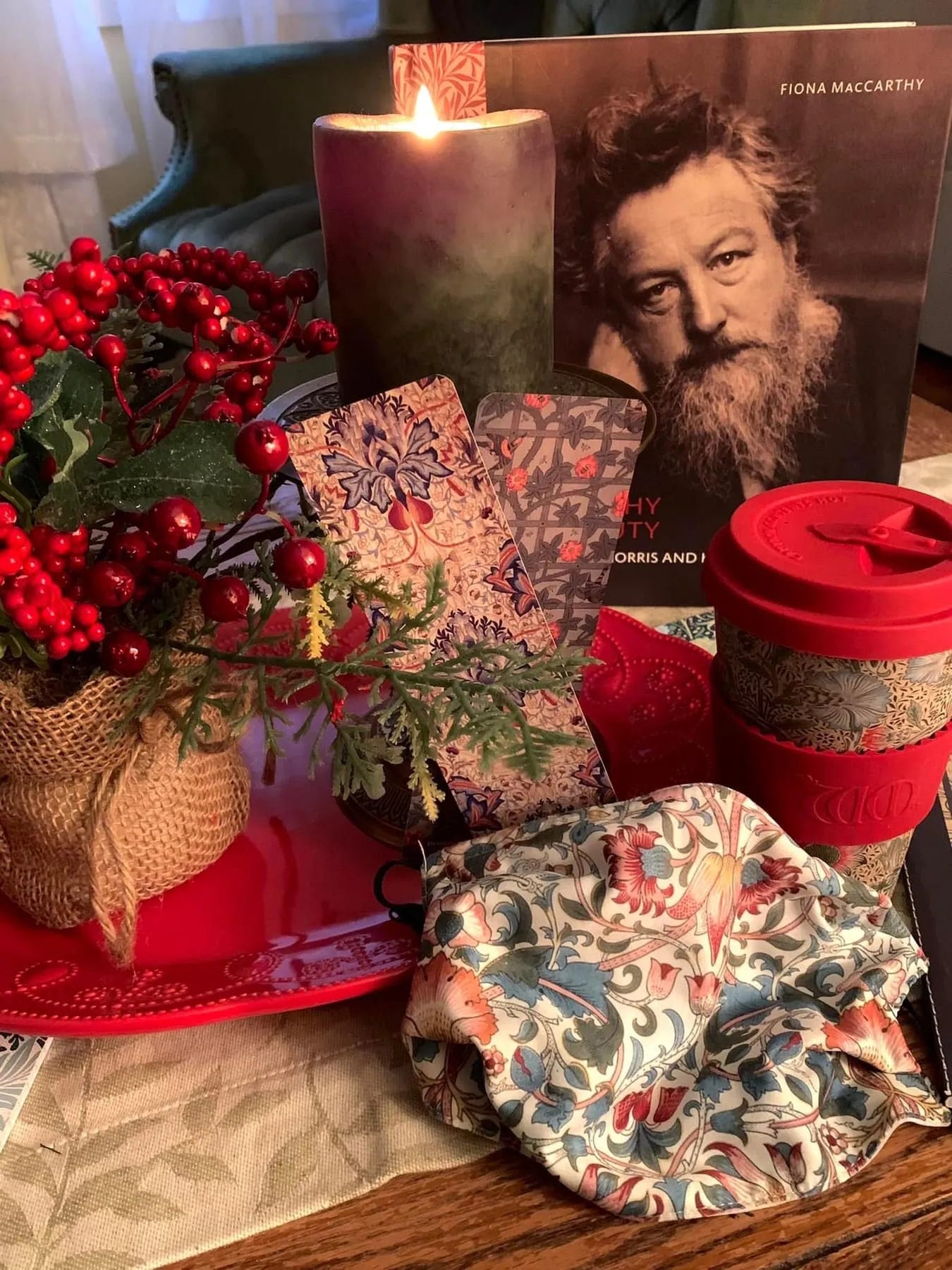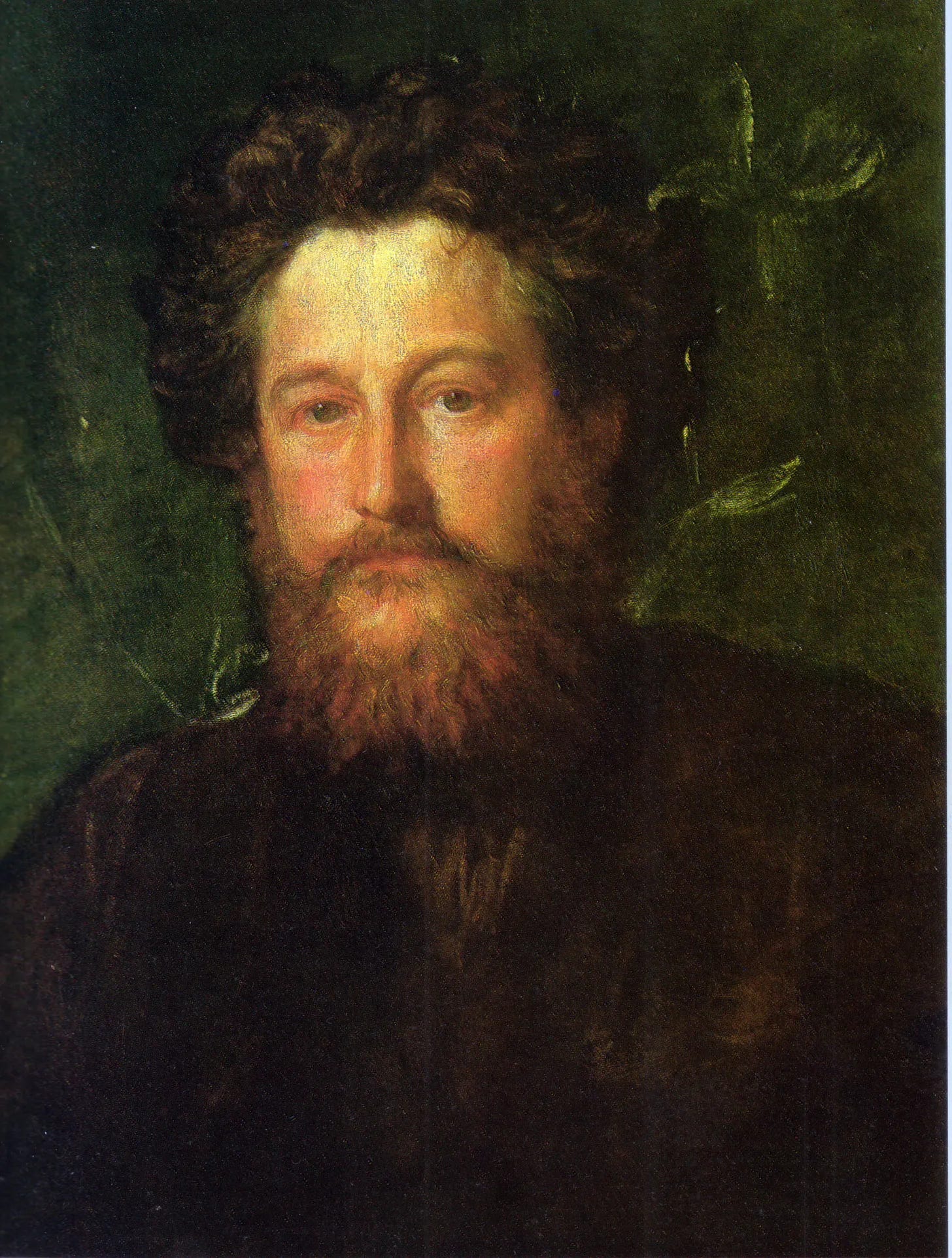I am wondering lately if I might not be completely obsessed with the likes of William Morris. Hmm. Perhaps maybe intervention worthy, even. I write in notebooks with his designs on the front. I sip tea from mugs wreathed round with his magical flowers. I pore over his designs in books my enabling children have gifted me for Christmas.
I have read his life, loved his poems, and feasted on the beauty of his wallpaper designs like a starving man. I even bought my husband a pair of Strawberry Thief socks. You see? Obsessed.
I sometimes feel like I belong to an unspoken secret society. During the Covid unpleasantness, I was working the ticket window one afternoon at the Botanical Gardens - I had my William Morris mask on (I told you, obsessed) and this lady comes sidling up to my window whispering low, "Morris?"
I nod my head covertly.
"Where?" whispers she.
"Etsy" whisper I.
And then we both nod knowingly as she mysteriously vanishes into the crowd.
We Morissers are, as they say…. everywhere.
It is odd when you have such an obsession with a hero. You begin to fashion him in your own romantic image. Certainly he must be beautiful and elf-like to have given us such images. A man who must clearly walk in a gauzy light and look dreamily up at the moon composing sonnets to his graceful ladylove. One who is tall, stately, and dressed impeccably - in white, flowing, renaissance shirts, of course. Quiet, calm, self-possessed. Dreamy eyed also being an option
.
Imagine my surprise, then, when I finally picked up some biographies of this wunderkind of my imaginings and found the living, breathing William. My idols came crashing down, mind you, but oh, they made a glorious noise.
William Shakespeare has an astute little sonnet, numbered 130, dedicated to his Mistress, in which he describes her as she is. No goddess. One whose eyes are nothing like the sun. Whose hair is likened to black wires. Whose cheeks are ‘okay’ but nothing like roses. A woman who, in no way, walks on air - but solidly on the ground. A woman he loves to listen to, though he does not hear sweet music in her tones, alas. This is a man under no delusions about the woman he loves. And yet, and yet, those last two lines.
And yet, by heaven, I think my love as rare
As any she belied with false compare
Shakespeare understood so well that the real is always better than the dream. The woman he loved was not the woman he fabricated. One cannot love a dream, no matter how perfect. It will always be false compare. There is only beauty in the truth. They go together always; even if it is the imperfect quirks with which you find yourself inexplicably falling in love.
This is how William emerged before me. My first impressions did not even come close to the truth. In fact, I found myself laughing out loud at how far I had missed the mark. I thought I heard Toad of Toad hall proclaiming loudly from atop the table, "You are ALL deceived!"
My own surprise was summed up in the clever words of the writer Andrew Lang when HE first met William Morris: "...oh, the shock of meeting your favorite poet and finding he looked like a … ship’s purser”. Indeed.
From the very beginning William was an anxious, impulsive child. Being outdoors was his natural habitat. He hated being inside and spent hours and hours tromping the fields and ponds around his country home with his sister, who was sent to look after him, which was code for ‘keep him out of mischief’. They played queens, kings, knights, and wove flower crowns and fashioned swords from sticks. William was like a piquant little sprite - a kind of fairy child. He reminded me of Dicken in “The Secret Garden”. His sister fell under his spell and soon learned to willingly enter his fantasy.
However, when his mother needed to punish him for the many things he broke, spilled, and tore; or the many times he went into his puzzling, little rages, she would make him stay inside the house. He would pace like a caged bird. From an early age, he hated and feared small, indoor spaces. His favorite spot when he was ‘caged’ like this was the large window on the landing of the front stairs. Here he would look at the sky and read Medieval tales of Knights and Ladies. These adventures would take him out into the wider world until he was released once again into the wild. He memorized all the flowers he saw, all the trees, every cloud. He was a bit of a savant and no doubt had his place on what we might so clinically call “the spectrum” in our own time. That spectrum where all the poets and artists dwell in unique colors and shades.
When William got older, he created the wallpaper we have come to love, so that all the outdoors would come inside as an extension of itself. I find this so beautiful. That such an art form was created to conquer a deep, claustrophobic fear within himself; art triumphing over deep and abiding anxiety. It’s something to ponder
!
As Morris got older he was, as a friend described him: “an irresistibly peculiar mixture, combining the roughness of the Norseman with the tenderness, even the shyness of a woman” ..he … "also swears awfully, and walks with a rolling gait, as if partially intoxicated." William had a strange jerkiness of movement, and a sometimes violent unpredictability of mood. He was intense, and had such a gift of observation that it almost "amounted to clairvoyance". W.B. Yeats had a portrait of Morris over his mantelpiece, so fascinated was he, and compared Morris's grave, wide-open eyes to "the eyes of a dreaming beast".
Unlike the dream I had woven, he was actually short, sturdily set, with a great shock of crazy hair on his head that was always mussed. This mop of hair earned him the name 'Toppers' by his chums at Oxford where he attended University. His arms were perpetually stained blue with his dyeing experiments. He read poetry out loud, VERY loud, in a sing song voice that resembled wind blowing - he never picked up one social cue that perhaps no one in the room wanted to hear poetry aloud at this time. He was a voracious reader. He was also an avid socialist, but struggled with the ideas of equality when it came to beautiful things. He wanted all men to have them in their homes, but he could never quite figure out how to produce the one of a kind pieces beauty and art demanded while preserving the human dignity of the worker and the creative uniqueness of the artist and make it - affordable. It proved always a far too expensive conundrum for him, but he kept at it.
He could never sit still. When thinking about painting a formal portrait of him, one artist approached Morris's good friend Bernard Shaw and asked if he would sit. Shaw tartly replied: "he's not to be drawn. It might be done with a Kodak, taking the same precautions as you would if you were garroting him ; but I know my man too well to suggest a sitting!"
Morris could do or make anything. He experimented constantly with different art forms. He bound books, he designed furniture. He was captivated by the Medieval tales of Canterbury, and Arthurian legends. He painted like a dream, embroidered, sewed, made incredible furniture. He could get utterly lost at his loom when weaving a new design. He neither heard, nor saw anyone in the room.
‘At the Loom’ Cartoon of Morris by his friend Edward Burne-Jones.
Once, when one of his customers remarked that the chair he was sitting in did not promote relaxation, Morris bluntly quipped, "if you want to relax, go to bed”. His was not a subtle nature. He himself never really did relax. He was too intent on filling up the world with beauty of thought, home goods, books, literature, poetry. He was driven! Beauty and art MUST prevail. He always lamented that there just wasn’t enough time to fill the world with exquisite things. That is ONE dream I had of him that really was true
.
He bought a house early on in his marriage and dubbed it the Red House. He invited his friends to spend hours and hours with him, painting the walls and cupboards and bedsteads with fairies, princesses, and Medieval scenes of all kinds. Tapestries were woven and hung over beds. Any and all sorts of people were invited to his home including Russian dissidents who escaped to England, suffragettes, women who studied philosophy or ran their own pottery businesses. They would all discuss, drink, and argue as equals! He was very fond of Oscar Wilde who would show up at his house among his eclectic guests with his signature crimson dahlia in his buttonhole. Wilde once wrote to Morris, "I have always felt that your work comes from the sheer delight of making beautiful things - that no alien motive ever interests you”.
And indeed, Oscar might have the last word on the matter, for it was so.
This portrait of William is nothing like I dreamed. My first impressions of him have since all flown out the window, but the wonderful human being that has replaced them is more remarkable by far.
The most poignant words about him come from his daughter May, who inherited his fine embroidery talent. "The thought of him and his work and his love has been for a good many years my only comfort and pleasure in life". She lovingly fashioned a small golden case which contained a lock of his famously unruly hair. William "Toppers" Morris.
I love him far more now than I ever did before, though my idols lay dashed upon the floor. And thus, may truth always be "more rare than any" it "belied with false compare.”
To William. Huzzah!
********************************************************
I do not feel inclined at this time to have a paid substack. But if we were together in a cafe discussing all these thoughts, I would not be opposed to you buying me a cup of coffee - with cream, of course. In that spirit, if any of my posts resonate with you and you feel so inclined, you can donate here: buymeacoffee.com/denise_trull









I am looking up the “Strawberry Thief” socks as soon as I send this…
Ok you're freaking me out. I purchased a "strawberry thief" bowtie on Etsy a couple of months ago for a special occasion from a maker in Ireland. I wonder if his design and this Morris fellow are linked.